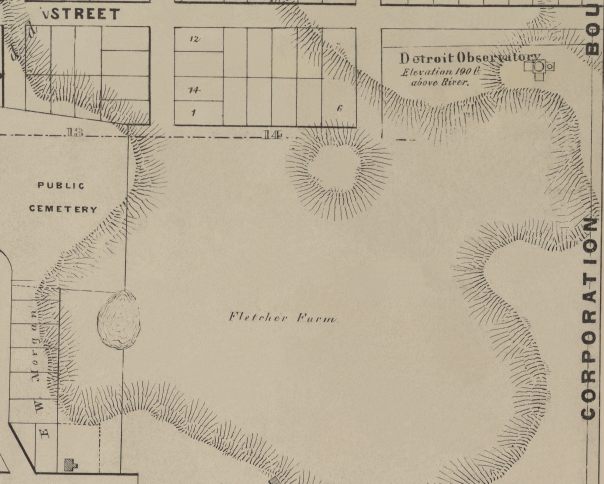The Detroit Observatory
Tappan’s Legacy
The Detroit Observatory once housed the largest telescope in North America and was the first of its kind. IT The observatory first appears in the 1854 map of Ann Arbor separated from central campus by the very large Fletcher Farm. Interestingly shaped hatch-marks on this area of the map seem to resemble a body of water, but in reality must denote elevation. The map notes that the elevation of the Detroit Observatory is 190 ft. above the Huron River. The Hill, it seems, was named for the actual topographical description, unlike the similarly named Hill Auditorium, which was named for University of Michigan regent Arthur Hill, whose estate funded its construction.

The 1854 Ann Arbor Map showing the newly completed Detroit Observatory
The Detroit Observatory was the brainchild of then university regent Henry P. Tappan. In his inaugural address in 1852, Tappan called upon the people of Michigan to support the university. This inspired prominent Detroiter Henry N. Walker to take up the cause and, following Tappan’s advice, began fundraising with the goal of establishing an astronomical observatory on the University of Michigan campus.
In 1853, having reached his fundraising goal, Henry Walker commissioned a design for an astronomical observatory from Professor Richard Harrison Bull of the University of the City of New York. According to Tappan’s original plan, the observatory was to be built on the University of Michigan Central Campus, however Tappan was in Europe on business at the time Walker began working with Bull, and this pair decided instead on a location outside of Ann Arbor overlooking the Huron River Valley. The four-acre plot on which the observatory still stands was purchased by the university at a rate of $100 per acre using the donations Walker had collected mainly from citizens of Detroit. As a sign of gratitude and love for his hometown, Walker decided on the name The Detroit Observatory. Upon his return from abroad, Tappan was unhappy with Walker and Bull’s choice of location, but by that time construction had already begun, so the chosen location was kept.
In the summer of 1854 the Detroit Observatory was completed. It featured a 23 foot dome and a 12 inch refractor designed by renowned American telescope maker Henry N. Fitz. It was the first astronomical observatory in Michigan. Prussian astronomer Franz Brünnow was appointed its director and head of the University of Michigan Astronomy department. For reasons unknown, Brünnow found Fitz’s original refractor to be inadequate and commissioned Fitz to make another custom model. The new refractor was to have a diameter of 12 ¼ inches, making it the largest refractor telescope in the North America and the third largest in the world.
In 1868, an addition was added to the west side of the Detroit Observatory. The addition was intended to be the residence of the observatory director, and served this purpose until 1942, at which point it was converted into a women’s dormitory. It served as such for four years until 1946, when converted into three private apartments. In 1954, however, the addition was demolished in order to create space for an addition to Couzens Hall.
Between 1908 and 1909, an addition was added to the east side of the Detroit Observatory. This addition was referred to as the principal building and housed a large reflector telescope, offices, classrooms, a darkroom, a laboratory, and a shop.
When the Physics and Astronomy building on East University was completed in 1963, the astronomy department moved out of the Detroit Observatory, leaving it vacant, and in 1976 the principal building was demolished.
Sources
-Abrahams, Peter. “Henry Fitz, American Telescope Maker.” Journal of the Antique Telescope Society 6, no. Summer 1994. Accessed March 15, 2017. http://www.europa.com/~telscope/fitz.txt.
-Mortenson, Myron. “Chronological Development of the University of Michigan Campus, Ann Arbor, Michigan.” Mort’s Labor of Love. [Ann Arbor, Mich.: The Dept., 1971. http://hdl.handle.net/2027/.
-Snyder, Dave. “The History of the Detroit Observatory.” Reflections of the University Lowbrow Astronomers, December 1997. https://www.umich.edu/~lowbrows/reflections/.
-University of Michigan. “College Notes.” The Michigan Technic, 1931. https//catalog.hathitrust.org/Record/000052394.
-Whitesell, Patricia S. A Creation of His Own: Tappan’s Detroit Observatory. Michigan Historical Collections, Bentley Historical Library, the University of Michigan, 1998.
-“Detroit Observatory: Nineteenth-Century Training Ground for Astronomers.” Journal of Astronomical History and Heritage 6, no. 2 (December 2003): 69–106.